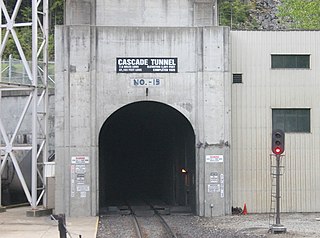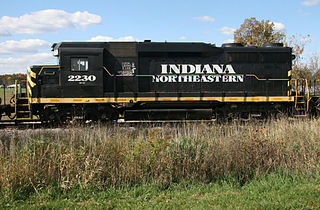The Pennsylvania Railroad, legal name The Pennsylvania Railroad Company, also known as the "Pennsy", was an American Class I railroad that was established in 1846 and headquartered in Philadelphia, Pennsylvania. At its peak in 1882, the Pennsylvania Railroad was the largest railroad, the largest transportation enterprise, and the largest corporation in the world.

The Chicago, Milwaukee, St. Paul and Pacific Railroad (CMStP&P), better known as the Milwaukee Road, was a Class I railroad that operated in the Midwest and Northwest of the United States from 1847 until 1986.

The Chicago, Burlington and Quincy Railroad was a railroad that operated in the Midwestern United States. Commonly referred to as the Burlington Route, the Burlington, CB&Q, or as the Q, it operated extensive trackage in the states of Colorado, Illinois, Iowa, Missouri, Nebraska, Wisconsin, Wyoming, and also in Texas through subsidiaries Colorado and Southern Railway, Fort Worth and Denver Railway, and Burlington-Rock Island Railroad. Its primary connections included Chicago, Minneapolis–Saint Paul, St. Louis, Kansas City, and Denver. Because of this extensive trackage in the midwest and mountain states, the railroad used the advertising slogans "Everywhere West", "Way of the Zephyrs", and "The Way West".

The Cascade Tunnel refers to two railroad tunnels, its original tunnel and its replacement, in the northwest United States, east of the Seattle metropolitan area in the Cascade Range of Washington, at Stevens Pass. It is approximately 65 miles (105 km) east of Everett, with both portals adjacent to U.S. Route 2. Both single-track tunnels were constructed by the Great Northern Railway.

The Reading Company was a Philadelphia-headquartered railroad that provided passenger and freight transport in eastern Pennsylvania and neighboring states from 1924 until its acquisition by Conrail in 1976.
The Detroit, Toledo and Ironton Railroad operated from 1905 to 1983 between its namesake cities of Detroit, Michigan, and Ironton, Ohio, via Toledo. At the end of 1970, it operated 478 miles of road on 762 miles of track; that year it carried 1,244 million ton-miles of revenue freight.

The Pennsylvania-Reading Seashore Lines was a railroad that operated in South Jersey in the 20th century. It was created in 1933 as a joint consolidation venture between two competing railroads in the region: the Pennsylvania Railroad and the Reading Company.

Conrail, formally the Consolidated Rail Corporation, was the primary Class I railroad in the Northeastern United States between 1976 and 1999. The trade name Conrail is a portmanteau based on the company's legal name. It continues to do business as an asset management and network services provider in three Shared Assets Areas that were excluded from the division of its operations during its acquisition by CSX Corporation and the Norfolk Southern Railway.

A joint railway is a railway operating under the control of more than one railway company.

The McCloud Railway was a class III railroad operated around Mount Shasta, California. It began operations on July 1, 1992, when it took over operations from the McCloud River Railroad. The MCR was incorporated on April 21, 1992.
The Lake Superior and Ishpeming Railroad, is a Class III railroad U.S. railroad offering service from Marquette, Michigan, to nearby locations in Michigan's Upper Peninsula. It began operations in 1896. The LS&I continues to operate as an independent railroad from its headquarters in Marquette.
Railroad electrification in the United States began at the turn of the 20th century and comprised many different systems in many different geographical areas, few of which were connected. Despite this situation, these systems shared a small number of common reasons for electrification.

The Sacramento Northern Railway was a 183-mile (295 km) electric interurban railway that connected Chico in northern California with Oakland via the state capital, Sacramento. In its operation it ran directly on the streets of Oakland, Sacramento, Yuba City, Chico, and Woodland. This involved multiple car trains making sharp turns at street corners and obeying traffic signals. Once in open country, SN's passenger trains ran at fairly fast speeds. With its shorter route and lower fares, the SN provided strong competition to the Southern Pacific and Western Pacific Railroad for passenger business and freight business between those two cities. North of Sacramento, both passenger and freight business was less due to the small town agricultural nature of the region and due to competition from the paralleling Southern Pacific Railroad.
The Texas Transportation Company was an electrified, Class III, short-line railroad in San Antonio, Texas, that operated from 1897 until 2001. It served the Pearl Brewery and several other businesses, moving carloads between those businesses and the Southern Pacific yard. Service ended on June 30, 2000, shortly before the Pabst Brewing Company closed the Pearl Brewery, in early 2001.

The Indiana Northeastern Railroad is a Class III short line freight railroad operating on nearly 130 miles (210 km) in southern lower Michigan, northeast Indiana and northwest Ohio. The Indiana Northeastern Railroad Company began operations in December 1992 and is an independent privately owned company. As of 2017 the railroad hauled more than 7,000 carloads per year. Commodities moved by the railroad include corn, soybeans, wheat and flour. It also handles plastics, fiberboard, aluminum, copper, coal, perlite, stone, lumber, glass, rendering products, as well as agricultural fertilizers and chemicals.

The Visalia Electric Railroad, a wholly owned subsidiary of the Southern Pacific Railroad (SP), began as an electric interurban railroad in Tulare County, in the U.S. State of California. The railroad was incorporated on April 22, 1904. Passenger service was discontinued in 1924, and the electrification was removed in 1944. Subsequent operation was by diesel locomotive. The railroad was closed in 1992.
North Roby, also known as Fisher, is a ghost town in north central Fisher County, Texas, United States, four and one half miles north of Roby. Its altitude is 1,932 feet (589 m).

The Elkhorn Grade Electrification was a project undertaken by Westinghouse in 1913–1915 to electrify a 27-mile (43 km) section of the Norfolk and Western Railway's Bluefield Division in Virginia and West Virginia. Electrification would be extended further in the 1920s and the length of the electrified line would reach 52 miles (84 km) before the N&W abandoned it in 1950 since the Elkhorn tunnel was re-built and re-opened with an easier grade and with a double track mainline.
The GE E25B is a class of four-axle 4,000 hp (3.0 MW) B-B electric locomotives made by General Electric (GE) in 1976–77. Only seven units were built, all for use by Texas Utilities on two short industrial freight lines.
The Waco, Beaumont, Trinity and Sabine Railway (WBT&S) was a standard gauge U.S. shortline railroad located in East Texas. The company was formed from two earlier shortlines that interchanged in Trinity, Texas, and had come under the control of the Missouri, Kansas and Texas Railway, but were spun off in 1923 as part of that company's bankruptcy reorganization. The WBT&S itself declared bankruptcy in 1930 and would operate under receivership for the rest of its existence—the longest bankruptcy in Texas rail history.












